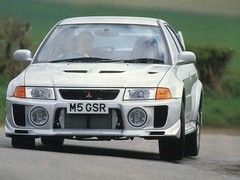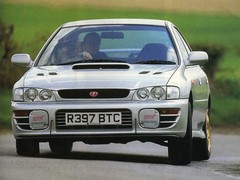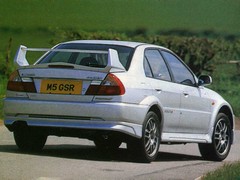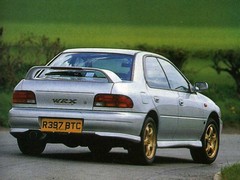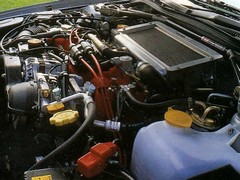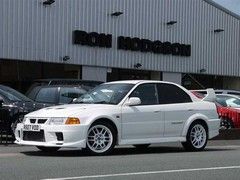Impreza STI vs Evo V: Foes Reunited
Rivalries don't come much more intense than this one; PH revisits the fight at its fiercest
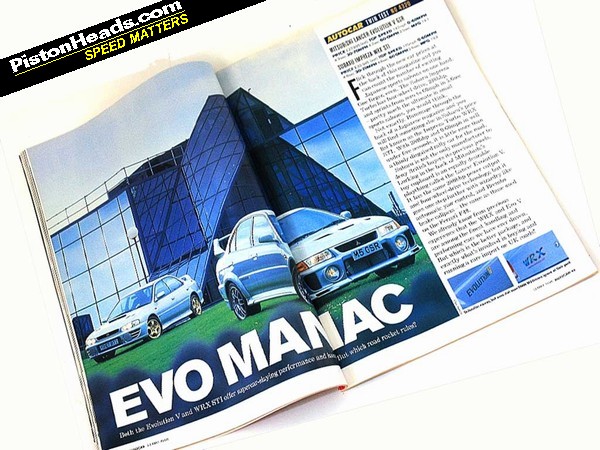
But despite the huge and untapped interest in both of these cars in 1998, neither Subaru nor Mitsubishi would officially sell you one in the UK. Instead, you'd have to the import. Star of this twin test was the Evo V. Recently launched to reflect the latest CP9A Lancer, the sharper-looking Evo boasted an even more extreme bodykit, 17-inch wheels that had been squeezed over new Brembo brake calipers, lightened pistons and strengthened internals for better tuning opportunities. Power remained at 280hp, torque was up to 275lb ft - but as we know, claimed power figures for both were pessimistic, as Autocar's performance figures would clearly demonstrate.
By '98, the WRX had also moved into its fifth evolution, and was now know as the GC8E. Power for the STI version remained at (again claimed, and rather pessimistic) 280hp, but the addition of forged pistons was an important change. As was Prodrive's increasing involvement with the Impreza. It had UK-tuned a few 22Bs that had been shipped into the UK on a semi-official basis. That relationship would flower in subsequent years.
First encounter
Autocar downplayed the encounter, not even flagging up the twin-test on the cover of a particularly busy issue. The magazine had tapped up two independent importers for the cars, and managed to post a full set of figures for both. "It's hard to understand just how fast these two cars are until you drive them," they said.
"In isolation, their peak power outputs of 280hp (the maximum allowed under Japanese regulations) do not sound that extreme. Of course, the extra traction made possible by the four-wheel drive configuration gives these giant-killers an advantage off the line." Both cars posted near-identical times - 0-30mph in 1.7 seconds for the Evo, and 1.5 for the STI. That closed up to 4.7 and and 4.6 for the 0-60 benchmark, with both making 12.3 seconds for the 0-100mph run. Clearly those figures made a mockery of their claimed power outputs, given the 1,275kg kerbweight of the Impreza and Evo's portlier 1,433kg.
In terms of handling, there was a little more between them. Autocar gave the Evo a full five stars, saying, "Despite the four-wheel drive hardware, the active yaw control, and the many driver aids, it's as capable, rewarding and exciting as any car we've driven in the past 10 years. We defy you to test this and come back with any other conclusion. It's a car that is extraordinarily easy to drive quickly, even to drivers of modest ability."
The STI scored four stars. "The Subaru comes close to emulating the Mitsubishi's talents, but with slightly lower limits and less adjustable chassis. Its natural bias is to understeer unless you throw it into a corner with McRae-style bravado. It's still a hugely talented car, and for what it's worth, has the more forgiving ride, but for driver satisfaction, the Evo V has the edge."
And that's how the verdict played out. Five stars for the Evo and four for the Subaru. "Either would make mincemeat of a BMW M3 down a B-road, not to mention faster, but more unwieldy supercars such as the Diablo, Cerbera or even the 911." But the Evo aced it for being just that little bit more special. "Here is a state-of-the-art Japanese car that uses technology to enhance rather than subdue the driving experience. And in the light of the Evo V, the Impreza's talents do not shine as brightly as they might."
Previous experience
The Subaru's brilliance today has been dulled a little by their ubiquity and what can only be described as a low-rent interior. But it's when you fire it up, listen to that flat-four rumble, and take it for a serious back-road strop that it all comes together. It's these intangibles that PHer Bradgate nails so effectively. "I owned one of these fantastic cars for four years and 70K miles, and I loved almost everything about it. The suspension felt like it had been specifically set up for British roads."
But there's more to the Impreza than its back-road performance, as they seem to get under your skin the longer you run them. Bradgate again. "I was devastated on the day I sold it, and I still miss it." LordHaveMurci agrees. "I had an R-reg one back in '99, kept it for four years and loved it to bits. Ate tyres for a pastime, but would love another, but only put off by the chavvy image."
Reliability and overall toughness of the Impreza earns huge praise. Gdaybruce couldn't fault his. "When it went, it was just shy of 100,000 miles and the only work required beyond routine servicing was to replace a rear seat belt that the dog chewed - and I can't blame that on Subaru! Both as a driving tool and as an ownership proposition, it's the best car I've ever had."
The heavier and more complex Evo is certainly more unusual. The bodykit is an acquired taste, and it's undoubtedly more showy. But really nail it, and there's just a little more grip and feel than the Impreza. But despite the Evo's reputation for being too hardcore for the road, driving one sensibly comes easily, and there's more than enough refinement to get by with.
Fury RS went the Evo route, but is open to idea of an Impreza, defining the confrontation perfectly. "Having owned an Evo IV, VI and a VII, in my opinion they are superb cars - I just prefer the looks and B-road ability that it gives. In saying that, I have driven a few Scoobys, and must say the later STIs went really well. I have been tempted on more than one occasion to switch over to the Darkside."
It's when you ask PHers to choose between the two that the really interesting comments - borne through experience - come out. But Baryonyx makes the best observations. "Buying with my heart, I'd be after an Evo, probably a Tommi Makinen in red. Buying with my head, definitely an Impreza STI. Even a UK-spec STI will provide 90 per cent of the fun of an Evo, but is more liveable for everyday use. You only realise how quickly the Evo's 4,500-mile service interval comes around when you're using the car every day! The STI may not have the 'niche appeal' of the Evo, but its success speaks volumes for its quality."
Back to the future
For many owners and enthusiasts, the V and the VI are still considered to be the definitive Evos to go for. The VI was the first Evo to be officially imported into the UK by Mitsubishi, which explains why there are so many of these available to buy in comparison with the V. Finding standard examples is difficult, but they are out there, with prices ranging between £5,000 and £15,000, with the majority of good, usable ones coming in from around £7,000. Tommi Makinen Editions, especially in UK-spec, are the ones everyone wants.
The sheer number of Imprezas means that you're spoiled for choice, with Japanese-spec WRXs starting at a shed money. Nice STIs are definitely worth searching out with our favourite Type-RA weighing in at proper Evo-style money, between £6,000 and £9,000. The market is well aware that the STI is a very different proposition to the more vanilla WRX, but despite that, there are some bargains to be had. Investment-grade Imprezas are also out there - pick up a nice P1 or 22B, squirrel it away, that's our advice. A good market view can be found here.
The Impreza's reliability and toughness are legendary, and as long as it's been properly serviced, on the button, there's no accident damage (or if there is, it's been properly fixed) and rust hasn't taken hold, then you're reasonably assured of reliability - as long as it's not too tired. There are caveats, but we've covered the more general ones in our recent Catch It While You Can story.
We've already covered buying an Evo in great depth here, and although it covers the more popular VI, it's relevant for the V, as well. It's a high-maintenance car, so be prepared for high running costs, and frequent visits to the 'shop. Servicing is needed every 4,500, and the cambelt needs replacing every four years or 40,000 miles. They're strong and reliable, but need lavish care to stay that way.
Rematch
In 1998, and out of our imported duo, Autocar went for the Mitsubishi, swayed by its incredible handling and lower price. But the market ended up disagreeing, moving massively in favour of the more accessible Subaru - with hot Imprezas literally flooding the UK, sparking a love affair that lived on through various generations for approaching a decade.
But 15 years ago, the bitter rivalry that sprung up between these two cars was really only beginning to take off in the UK, and the verdict was declared without all the pomp and circumstance we'd later come to associate with the pair. And it wasn't really until the arrival of the Evo VI Tommi Makkinen to battle with the Type RA/22B/RB5/P1, that both cars came of age.
When PHers are quizzed on which is the better of the two, the consensus is that the sprint-geared Evo makes the better track day car, and the Impreza is the one to have everywhere else. And that's an opinion we'd struggle to argue with. Factor in that non-special edition Imprezas STIs are cheaper to buy, and it's a clear winner, convincingly turning over Autocar's 1998 verdict.
But deep down, despite the Subaru's all-round brilliance, there's a certain intangible that leaves us thinking that after a particularly brutal B-road thrash, the Evo leaves its driver feeling just a little more special. Over to you...
MITSUBISHI LANCER EVOLUTION V GSR
Engine: 1,997cc 4-cyl, turbocharged
Transmission: 5-speed manual, 4-wheel drive
Power (hp): 280@6,500rpm
Torque (lb ft): 275@3,000rpm
0-60mph: 4.7 sec
Top speed: 147mph
Weight: 1,433kg
MPG: N/A
CO2: N/A
Price then: £27,995
Price now: £5,000-£10,000
From the classifieds:1998 Mitsubishi Evo V, £7,994
Why you might: Minimal modifications, even on its original wheels, extensive UK history
SUBARU IMPREZA WRX STI
Engine: 1,994cc inline four-cylinder
Transmission: 5-speed manual, 4-wheel drive
Power (hp): 280@6,500rpm
Torque (lb ft): 260@4,000rpm
0-60mph: 4.6 sec
Top speed: 150mph
Weight: 1,275kg
MPG: N/A
CO2: N/A
Price then: £32,995
Price now: £2,000-£10,000
From the classifieds:2000 Subaru Impreza WRX STI Type RA, £7,750
Why you might: Limited edition, no modifications, two owners.
Loved my Evo v. Best looking Evo too I think and mine had a lot more than the official bhp. Would destroy many performance cars of the day once the rain came down. Remember catching a hartage and amg merc driving 'spiritedly' near Newtown in Wales. I was late and they could not keep me behind, out of a corner it had so much traction it stormed passed while they fishtailed.
Was quite addictive, I even enjoyed catching up with traffic on my favourite driving road just for the pleasure of using the power and traction. The ayc was programmed spot on. With the Motorsport ECU option, it meant no understeer but it was pricey to service and replace when it eventually wore out.
Glad it had the brembo brake option as they were very powerful but did eat disks. The clutch was compromised, the standard was too soft to make it easier to pull away, but you could destroy it in a could of launches, so it's worth replacing with something better.
Does anyone regard them as a sensible buy? I've always wanted one but the hassle finding one that hasn't been thrashed within an inch of its life and not looked after properly puts me off. Or were they purchased by people in the know whereas the Impreza can be found squealing round Appleby horse fair?
Surprisingly good on petrol though.
 ) and the Toyota handled better in that it was more fun and softer in roll at the rear. But the STi would out grip it.
) and the Toyota handled better in that it was more fun and softer in roll at the rear. But the STi would out grip it.However the Evo handled much sharper than the gt4, gripped as well as the STi but would drift controllably and never understeered.
I had the v, then went to a blob STi. The Evo was slightly better. The ride is great, did Milan to lancaster in it, comfort was fine. Every day driver for me. Front diff did weight up the steering a bit in tight slow corners, junctions etc (but far better than my carrera). Great everyday car. Practical (could get my mtb In the boot), fast, economy was not too bad for the time (got about 25 mpg) good looking, and rare when I had it.
Also raw enough to feel like it had competition roots. The turbo installation was characterful, would surge a little but throttle reps sons was good. It's just the cost of maintaining that would put me off now.
The active yaw control rear diff was a very good development by Mitsubishi. I drove one at Bruntingthorpe and the ECU corrected my attempts at deliberate oversteer every time.
But, at the end of the day, it is what it is intended to be - A driver aid.
Mine did not react to the driver to undo a mistake (ie driver aid) rather is made the chassis react in a predictable way. It did feel strange at first because it would give the impression that the car was rotating so fast on turn in, that huge oversteer was bound to follow and when you instinctively wound off some lock in preparation to catch it, the ayc would prevent the snap oversteer.
It might be a small difference, but I see it as a chassis tuning aid ie it makes the car respond in a certain way. Mine would oversteer on demand on roundabouts, 4 wheel drift at high speed while being stable and never, ever understeer. it did have the Motorsport ECU for the ayc and was well worth it (just wore out the ayc) but I believe the standard program worked the same way just slightly slower in actuation.
The active yaw control rear diff was a very good development by Mitsubishi. I drove one at Bruntingthorpe and the ECU corrected my attempts at deliberate oversteer every time.
But, at the end of the day, it is what it is intended to be - A driver aid.
Mine did not react to the driver to undo a mistake (ie driver aid) rather is made the chassis react in a predictable way. It did feel strange at first because it would give the impression that the car was rotating so fast on turn in, that huge oversteer was bound to follow and when you instinctively wound off some lock in preparation to catch it, the ayc would prevent the snap oversteer.
It might be a small difference, but I see it as a chassis tuning aid ie it makes the car respond in a certain way. Mine would oversteer on demand on roundabouts, 4 wheel drift at high speed while being stable and never, ever understeer. it did have the Motorsport ECU for the ayc and was well worth it (just wore out the ayc) but I believe the standard program worked the same way just slightly slower in actuation.
Within two years the EVOs had taken over the MLR.
I just feel that a driver aid, is something that only intervenes when you make a mistake, then takes over and restores control. Whereas the ayc is much more of a device to set the handling characteristics of this chassis. You can still bin one big style. However I would concede that it is an aid in so far as it maintains control of the rear to prevent it spinning which reduces the reliance on the driver to do so.
Took my old ayc to bits. Was a fascinating bit of kit (then BMW started crowing about how they had the first system that worked like this in the x6).
Most of the stories I hear about Subarus blowing engines are on the internet, I can only think of one among the many Subaru owners I know in the real world, and that was a freshly imported car of unknown history being given an absolute caning.
Just goes to show you can get a completely opposite impression from a small sample size

The 5 speed Evo box was tough as old boots especially with its semi straight cut first, it did whine a bit but could take the torque. I believe the road derived later boxes were not quite as strong.
The active yaw control rear diff was a very good development by Mitsubishi. I drove one at Bruntingthorpe and the ECU corrected my attempts at deliberate oversteer every time.
But, at the end of the day, it is what it is intended to be - A driver aid.
Mine did not react to the driver to undo a mistake (ie driver aid) rather is made the chassis react in a predictable way. It did feel strange at first because it would give the impression that the car was rotating so fast on turn in, that huge oversteer was bound to follow and when you instinctively wound off some lock in preparation to catch it, the ayc would prevent the snap oversteer.
It might be a small difference, but I see it as a chassis tuning aid ie it makes the car respond in a certain way. Mine would oversteer on demand on roundabouts, 4 wheel drift at high speed while being stable and never, ever understeer. it did have the Motorsport ECU for the ayc and was well worth it (just wore out the ayc) but I believe the standard program worked the same way just slightly slower in actuation.
Within two years the EVOs had taken over the MLR.
I just feel that a driver aid, is something that only intervenes when you make a mistake, then takes over and restores control. Whereas the ayc is much more of a device to set the handling characteristics of this chassis. You can still bin one big style. However I would concede that it is an aid in so far as it maintains control of the rear to prevent it spinning which reduces the reliance on the driver to do so.
Took my old ayc to bits. Was a fascinating bit of kit (then BMW started crowing about how they had the first system that worked like this in the x6).
Rather than something that STOPS you loosing control in the first place by diverting power and correcting a slide - in such a way that you were not aware of it.
I guess we do just draw that line differently the,...
Question.
Have you driven an RS version of your car?
A totally different experience on the tyre limit that really drives home my point on how AYC makes a huge difference to what is essentially the same car.
I feel the ayc is part of the way the gsr drives, whereas something like a 407's stability control is a driver aid.
Don't have the Evo anymore. Got an 89 carrera now with no driver aids apart from the steering wheel

Gassing Station | General Gassing | Top of Page | What's New | My Stuff

